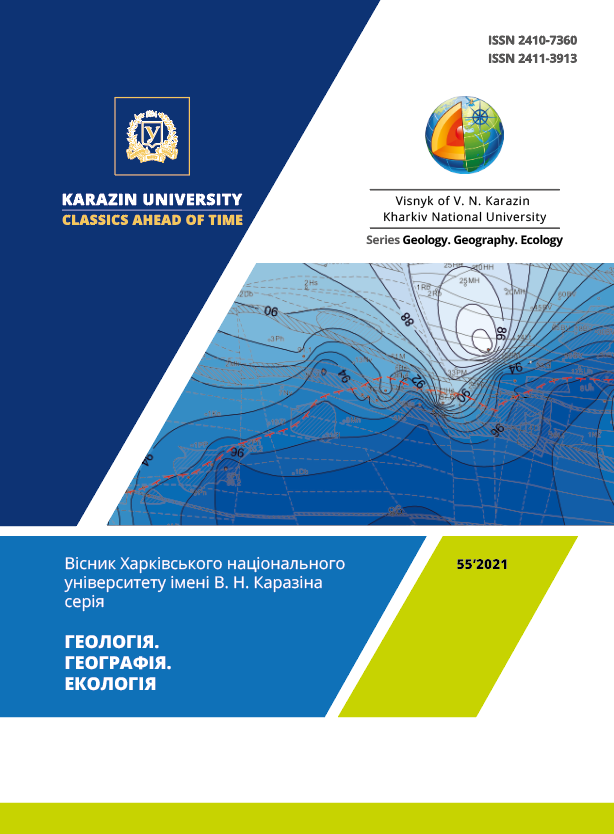Оцінювання екологічних ризиків розвитку підземної транспортної інфраструктури методом BOCR
Анотація
Проаналізовані характерні екологічні та техногенні загрози міському середовищу. Розглянуто пріоритетні для безпеки людини і суспільства задачі мінімізації екологічних і техногенних ризиків в умовах швидко зростаючих мегаполісів. Оцінено можливості підземних споруд взяти на себе функції найбільш небезпечних та ризикованих поверхневих об’єктів і комунікацій. Побудовано моделі підтримки прийняття рішень для оцінювання альтернатив трас автомобільних тунелів у місті Києві. Розкрито методику й проведено оцінювання моделей розвитку підземної транспортної інфраструктури столиці методом BOCR (критерії доходів, можливостей, витрат і ризиків). Розглянуто задачу оцінювання пріоритетності моделей (альтернативних варіантів) розвитку підземної інфраструктури міста, яка характеризується умовами унікальності, можливої неповноти, неточності, нечіткості вхідної інформації. При цьому використано результати експертного оцінювання об’єктів. Розраховано агреговані за мережею параметрів пріоритети альтернатив для трас тунелів м. Києва і обґрунтовано доцільну послідовність їх будівництва за критеріями зниження екологічних і техногенних ризиків урбанізованого простору. Зокрема, застосування методу BOCR дозволило вибрати найбільш пріоритетну альтернативу – тунель №5 за Генеральним планом розвитку Києва до 2025 року. Метод є гнучким, за його допомогою можуть бути оцінені будь-які інші території (траси) потенційного підземного будівництва у великих містах. Отже, практичне значення роботи полягає в створенні й апробації універсальної методики, що дає інвесторам і міським державним адміністраціям ефективний інструментарій оцінки першочерговості будівництва об’єктів підземної інфраструктури для регулювання міського розвитку з метою підвищення екологічних стандартів і безпеки життєдіяльності мегаполісів.
Завантаження
Посилання
World Urbanization Prospects 2018: Highlights. United Nations. New York (2019). Available at: https://population.un.org/wup/Publications/Files/WUP2018-Report.pdf
Regional report on the state of the environment of Kyiv for 2017. Kyiv City State Administration. Available at: https://mepr.gov.ua/files/docs/%D0%9C.%20%D0%9A%D0%98%D0%87%D0%92.pdf
Klymchyk, O. M., Bahmet, A. P, Dankevych, Ye. M., Matkovsʹka, S.I. (2016). Ecology of urban systems. Zhytomyr: Publisher О. О. Evenok, 460.
Korendyaseva, Ye. V. (2017). Environmental aspects of city management. Moscow: MGUU Moscow Government, 162.
Stolberg, F. V. (2000). Ecology of the city. Kyiv: Libra, 464.
Prepotenska, M. (2014). Homo Urbanus: the human phenomenon of the metropolis. Dnepropetrovsk: Ed. Serednyak T.K., 420.
Golubev, G. E. (2005). Underground urbanism and the city. Moscow: MIKHiS.
Gilbert, P. H. et al. (2013). Underground Engineering for Sustainble Urban Development. Washington: The National Academies Press.
Kartoziya, B. A. (2015). Development of underground space in large cities. New trends. Mining information and analytical bulletin (scientific and technical journal), (1), 615-629.
Hayko, H. I., Matviychuk, I. O., Biletsʹkyy, V. S., Saluha, P. (2018). Methods of forecast assessment of the favorable geological environment for the construction of underground urban planning objects. Visnyk of V. N. Karazin Kharkiv National University, Series "Geology. Geography. Ecology", (48), 39-51. https://doi.org/10.26565/2410-7360-2018-48-03
Pankratova, N. D., Hayko, H. I., Savchenko, I. O. (2020). Development of underground urban planning as a system of alternative design configurations. Kyiv: Scientific thought. 134.
Bezlyubchenko, O. S., Hordiyenko, S. M., Zavalʹnyy, O. V. (2008). Urban planning and transport. Kharkiv: KNAMG. 156.
Hayko, H. I., Bulhakov, V. P., Siveryn, M. O. (2016). The system of automobile tunnels as a way to solve transport and environmental problems of the metropolis. Bulletin of NTUU "Kyiv Polytechnic Institute". Series "Mining", (30), 196-206.
Vähäaho, I. (2014). Underground space planning in Helsinki. Journal of Rock Mechanics and Geotechnical Engineering, (6).
Sterling, R., Admiraal, H., Bobylev, N., Parker, H., Godard, J. P., Vähäaho, I., Shi, X., and Hanamura, T. (2012). Sustainability issues for underground spaces in urban areas. Proceedings of ICE. Urban Design and Planning, 165(4), 241–254.
Resin, V.I., Popkov, YU.S. (2013). Development of large cities in a transitional economy. Systems approach. Moscow: Book House "LIBROKOM", 328.
Popkov, Yu. V., Posokhin, M. V., Gutnov, A. E., Shmul'yan, B. A. (1983). System analysis and problems of urban development. Moscow: Science. 368.
Nedashkivsʹka, N. I. (2018). 18. A systematic approach to decision support based on hierarchical and network models. Systems research and information technology, (1), 7-18. https://doi.org/10.20535/SRIT.2308-8893.2018.1.01
Nedashkivska, N. I. (2013). A method of consistent pairwise comparisons for decision alternatives evaluation in terms of a qualitative criterion. System research and information technologies, (4), 67–79.
Pankratova, N. D., Nedashkovskaya, N. I. (2018). Evaluation of Ecology Projects for Black Sea Odessa Region on Basis of a Network BOCR Criteria Model. IEEE First International Conference on System Analysis & Intelligent Computing (SAIC), October 2018. https://doi.org/10.1109/SAIC.2018.8516900
Pankratova, N. D., Nedashkovskaya, N. I. (2016). Estimation of Consistency of Fuzzy Pairwise Comparison Matrices using a Defuzzification Method. V. A. Sadovnichiy and M. Z. Zgurovsky (eds.). Advances in Dynamical Systems and Control, Studies in Systems, Decision and Control, (69), 375-386. https://doi.org/10.1007/978-3-319-40673-2_20.
Nedashkovskaya, N. I. (2016). Stability of local weights of decision alternatives on basis of pairwise comparison method. System research and information technologies, (4), 14-22. https://doi.org/10.20535/SRIT.2308-8893.2016.4.02
Nesticò, A., Elia, C., Naddeo, V. (2020). Sustainability of urban regeneration projects: Novel selection model based on analytic network process and zero-one goal programming. Land Use Policy, (99). https://doi.org/10.1016/j.landusepol.2020.104831.
Mohammed Ameen, R. F., Mourshed, M. (2019). Urban sustainability assessment framework development: The ranking and weighting of sustainability indicators using analytic hierarchy process, Sustainable Cities and Society, (44), 356-366. https://doi.org/10.1016/j.scs.2018.10.020
Doyle, M. R. (2020). Mapping urban underground potential in Dakar, Senegal: From the analytic hierarchy process to self-organizing maps, Underground Space, 5 (3), 267-280. https://doi.org/10.1016/j.undsp.2019.04.004.
Peng, J., Peng, F-L (2018). A GIS-based evaluation method of underground space resources for urban spatial planning: Part 1 methodology, Tunnelling and Underground Space Technology, (74), 82-95. https://doi.org/10.1016/j.tust.2018.01.002.
Master plan for the development of Kyiv and its suburbs until 2025 (draft). Available at: https://kga.gov.ua/generalnij-plan





